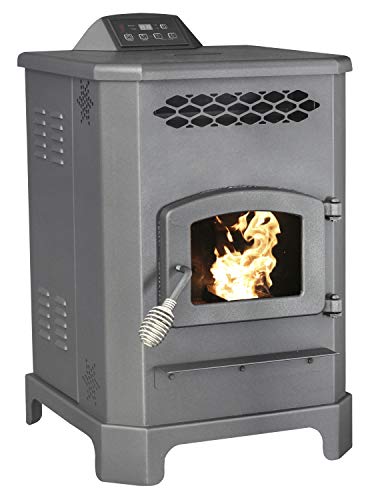You'll Be Unable To Guess Pellet Stove Furnace's Tricks
Neal
0
19
2024.11.29 22:30
 best pellet stove inserts stove furnace, Read More On this page,
best pellet stove inserts stove furnace, Read More On this page,Pellet stoves can be used as a second heat source or, if you have proper venting, a primary heating option. They can be purchased in freestanding units as well as fireplace inserts that can give your home the appearance of a traditional wood-burning fireplace.
The auger moves pellets from the hopper to the combustion chamber, where they are burnt and generate heat. Sensors are able to monitor the flame and adjust the speed of operation in order to maintain the desired temperature of the room.
1. Energy Efficiency
Pellet stoves use a non-toxic, renewable fuel made from compressed sawdust and other materials. They are typically removed from landfills, but they can be used to create a clean, efficient source of heat. They can help homeowners reduce their energy consumption and reduce greenhouse gas emissions. Many people who use pellet stoves report that they have recouped their initial investment in only few years by reducing their heating bills.
Pellets are much more dense and compressed than natural wood, which makes them more efficient in burning. They also produce less creosote than traditional wood-burning fires. They are also packaged in plastic bags that seal out moisture, and require less frequent cleaning.
Like other heating systems pellet stoves must be properly sized and vented. A skilled technician can assess your venting requirements and space to ensure the best pellet stove results.
In the process of installation, the hearth is built to size and the vent is inserted through a pre-cut hole in your home's siding. The vent can be run through a sidewall or roof depending on your preference and the local laws.
After the vent and hearth are completed the pellet stove can be plugged in. Some manufacturers provide a remote control that makes starting and maintaining the fire easy while others come with additional sensors that monitor airflow, combustion flue temperature, pressure. If the system determines that it requires more pellets or less, it will signal to the auger that it should speed up or slow it down in line with the needs.
All stoves have a hopper for storage that holds between 35 and 130 pounds of pellets until they're needed. Hopper capacities determine the frequency at which the stove has to be refilled with more hoppers, allowing for longer intervals between refills. A grille pulls air from the room, then passes it over the heat exchanger, and then blows heated air through the living area through convection. A grate or auger spreads the pellets, and an under-sink pan collects any unburnt ones as well as the ashes of combustion.
Pellet stoves are less energy-intensive than wood-burning models, but aren't as efficient as natural gas or electric furnaces. The electric components that drive their motorized parts require a power source which could cause a problem during a power failure, but backup systems are readily available, such as batteries and generators.
2. Low Maintenance
Pellet stoves are extremely efficient, however they require some maintenance in order to function properly. Cleaning your stove and exhaust vent regularly will stop the accumulation of harmful creosote, which could lead to a fire or an explosion that can damage your stove or even your home.
A pellet stove makes use of natural particles that are compressed (such as nutshells, kernels of corn or tiny pieces of scrapwood) made from wood or other materials. The pellets are fed into the combustion chamber through an auger powered with electricity. The rate at which the pellets are fed into the burner is controlled by the thermostat you set. The fire can be kept burning, or it can be decreased or even extinguished in accordance with the temperature you set. When the fire is gone the ash is thrown into an empty ash tray underneath the burner, which can be easily removed and disposed.
Pellets are made from byproducts from lumber processing which would otherwise be thrown away. They are a renewable source and emit less dust than traditional wood-burning appliances making them a cleaner burning heat source. The amount of carcinogens, carbon monoxide and other harmful chemicals released from pellet stoves is less than the latest EPA certified wood stoves.
These stoves aren't required to be vented via a chimney, like is the case with traditional wood stoves. Instead, they can be vented correctly through a wall, or another exterior structure. Pellet stoves are equipped with flue ports on the top or rear of the appliance. They are connected to a ventpipe that extends out from the house.
A pellet stove comes with one drawback it requires you to purchase or store enough fuel pellets for the entire winter season. outdoor pellet stove stove owners typically consume three tons of wood pellets per winter, for a price of $200 per ton. The costs can add up over the years however it's much less expensive than buying and hauling firewood to traditional fireplaces or stove. Make sure that you purchase enough pellets so that your stove will work through the coldest winter months, and that you have the right space to store the pellets (preferably dry, cool and off the ground).
3. Reduced Carbon Footprint
Pellet stoves utilize renewable biomass fuel to generate heat, which reduces the need for fossil fuels that are finite. This reduces carbon footprints and increases the diversity of energy sources for homes.
Even the newest woodstoves that are EPA certified emit considerably less than pellet stoves. The emissions from pellet stoves also are much lower than ones from gas furnaces. Pellets can be made of sawdust or bark, as well as other wood remnants. They can also include soybeans, corn, or agricultural waste. When they are burned, they release less particulates (leading to respiratory problems and allergies) carcinogens and carbon monoxide as well as the nitrous oxides.
The feed system is the main difference between a pellet stove and a wood stove. Pellet stoves are equipped with hoppers to store the pellets. When the thermostat or sensors suggest that the room needs heating, the furnace turns and the pellets are fed into the combustion chamber, where they burn and generate heat. The combustion chamber is pushed through a heat exchanger that transmits the heat to the blower before releasing it into the room. This process results in low emissions and no creosote buildup.
After the hopper is empty, the ash gets removed by a cyclone, and deposited in an ash container. The stove is fitted with an air-flow system that circulates the warm, fresh air into the room. The majority of pellet stoves require little maintenance and feature a large viewing space for you and your family to enjoy the flames.
The quality of pellets is the main factor that affects the emissions from pellet stoves. Poor-quality pellets will produce more emissions. When selecting your pellets ensure they meet certain standards and do not contain other ingredients, such as urea or petroleum-based products. Also, look for a manufacturer that offers a guarantee and will repair or replace parts in the event of a problem. If you want to take an environmentally friendly approach, some states permit homeowners to claim a tax credit for installing pellet stoves. This is a great option to offset the initial costs of this kind of stove and make installation more affordable.
4. Reduced Noise
indoor pellet stove stoves produce less smoke and exhaust in comparison to wood-burning fireplaces. A fan is used to spread heat more evenly across the room. This is among the reasons why pellet stoves require less maintenance than traditional wood stoves. While wood stoves need to be regularly cleaned of dust and chemicals pellet stoves require an specialized metal vacuum cleaner for routine cleaning.
Many manufacturers have made a conscious effort to design their stoves to be simple to set up and to operate as well as maintain. They also offer their stoves in a wide range of styles that can be matched to your home's decor. Certain models come with an app for WIFI, a remote control and thermostat that can be programmed.
The majority of pellet stoves come with an enormous fuel hopper, which can hold 35 to 130 pounds of pellets. The pellets are then fed to the combustion chamber through an auger. The speed at which pellets are delivered to the burner determines how hot the flame is and also the amount of heat produced. The hopper could be filled with hardwood pellets made from dense wood species like hickory and oak, or softwood pellets. Many stoves can also burn alternative biomass pellets, such as those made from switchgrass or corn which are an environmentally friendly option.
pellet stove stores near me stoves emit less smoke and require less maintenance due to the fact that they use cleaner fuel than wood-burning fireplaces. They do not need chimneys, making them a better choice for retrofits or new construction.
As opposed to wood stoves that require regular maintenance to keep free of creosote as well as other chemicals, pellet stoves only need to be periodically inspected for proper operation and maintenance. Depending on the model, this might include regular inspections and cleaning of the accumulation of ash or "clinker," as well as the fan and motor. Your appliance dealer will be able to explain the proper procedure for your specific brand and model. He can also provide you with information about storage and safety and assist you in finding the appropriate fuel for your stove.





